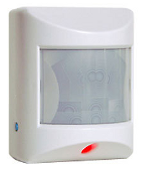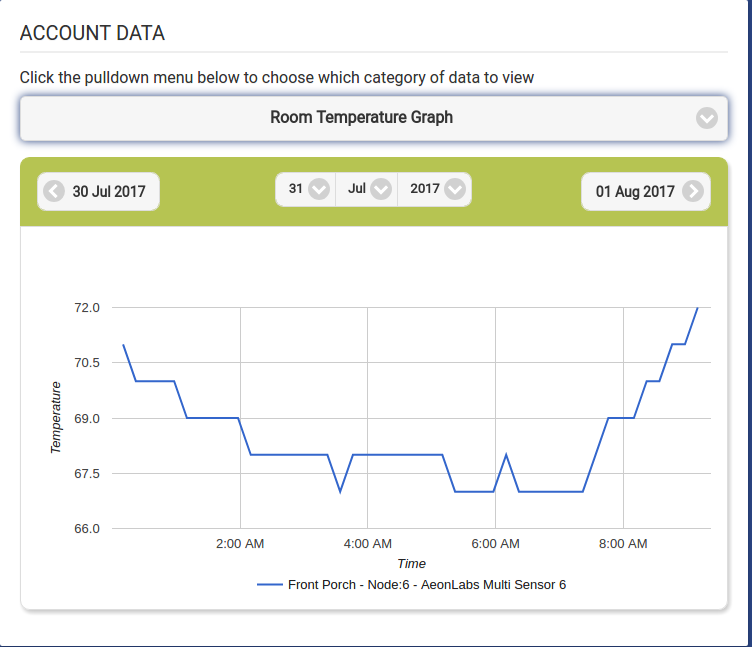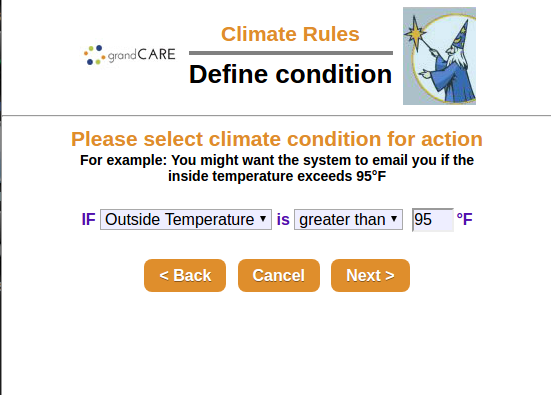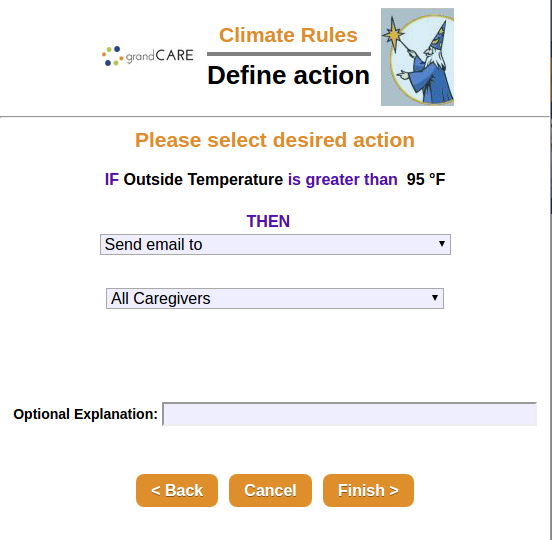Difference between revisions of "Temperature"
m (Changed wording on pdf link and removed TOC) |
|||
| (4 intermediate revisions by 3 users not shown) | |||
| Line 1: | Line 1: | ||
__NOTOC__ [[File:ZWaveTempSensor.png|right|frame|Z-Wave Temperature and Motion Sensor]] | __NOTOC__ [[File:ZWaveTempSensor.png|right|frame|Z-Wave Temperature and Motion Sensor]] | ||
[[File: | <table> | ||
< | <tr><td valign="top">[[File:SmartHomeIcon.png|left|Activity Monitoring]]</td> | ||
If you are concerned that your loved one's home might get too hot or too cold, a wireless temperature sensor can help you. The sensor reports the current indoor temperature, as well as graphs of the temperature over time. You can set limits for how high or low the temperature can be, so you and other caregivers can receive alerts if those limits are exceeded. You can receive alerts on outside temperature or humidity as well, based on the [[Weather|system's weather report]] for the city you selected.< | <td> | ||
===Overview=== | |||
<br /> | |||
If you are concerned that your loved one's home might get too hot or too cold, a wireless temperature sensor can help you. The sensor reports the current indoor temperature, as well as graphs of the temperature over time. You can set limits for how high or low the temperature can be, so you and other caregivers can receive alerts if those limits are exceeded. You can receive alerts on outside temperature or humidity as well, based on the [[Weather|system's weather report]] for the city you selected.</td></tr> | |||
</table><br /> | |||
===Types of Sensors=== | |||
There are two different types of temperature sensors that can be used with your loved one's system. One is a combination sensor that does double duty as both a motion sensor and a temperature sensor. The other is a dedicated temperature sensor. Your support representative or installer should help you choose the sensors that are right for your needs. If those needs change, different sensors can be added to the system at a later date. As part of the installation process, the sensors must be paired with your system, so that the signals are picked up properly. <br /><br /> | There are two different types of temperature sensors that can be used with your loved one's system. One is a combination sensor that does double duty as both a motion sensor and a temperature sensor. The other is a dedicated temperature sensor. Your support representative or installer should help you choose the sensors that are right for your needs. If those needs change, different sensors can be added to the system at a later date. As part of the installation process, the sensors must be paired with your system, so that the signals are picked up properly. <br /><br /> | ||
[[File:Temp_Graph.png|400px|thumb|right|frame|Temperature Graph]] | |||
===Checking the Temperature Graphs=== | |||
* [[Logging In|Log in to the Online Care Portal]] | * [[Logging In|Log in to the Online Care Portal]] | ||
* | * Go to the Account of the Resident you wish to check the temperature graph of. | ||
* Click the " | * Click the "Data" tab towards the top of the page - this displays all data from the system. | ||
* Click the " | * Click the drop down bar (Note: This usually will say "Activity Summary" when you first access the page) | ||
*Select the "Room Temperature Graph" Option - if a system has a sensor setup that records temperature, a graph will appear of the day's temperature readings. | |||
*You can also view a report of the temperature data from a specific time period by clicking the "Reports" button and generating a new report | |||
[[File: | ::[[Reports|More Info on Reports]] | ||
[[File: | [[File:Climate_Rules1.png|400px|thumb|right|frame|Set a Climate Rule Condition]] | ||
[[File:Climate_Rules2.png|400px|thumb|right|frame|Set a Climate Rule Action]] | |||
===Setting Rules=== | |||
You can set up rules to alert caregivers when the indoor temperature goes above or below values that you define. You can also set up rules to report when the outdoor temperature goes outside of your defined limits. The outdoor temperature is taken from the [[Weather|system's weather forecast]], based on the city that you selected for the system. To add a rule: | You can set up rules to alert caregivers when the indoor temperature goes above or below values that you define. You can also set up rules to report when the outdoor temperature goes outside of your defined limits. The outdoor temperature is taken from the [[Weather|system's weather forecast]], based on the city that you selected for the system. To add a rule: | ||
* [[Logging In|Log in to the Online Care Portal]] | * [[Logging In|Log in to the Online Care Portal]] | ||
| Line 31: | Line 36: | ||
* Outdoor humidity below a level you choose<br /><br /> | * Outdoor humidity below a level you choose<br /><br /> | ||
Once you have defined the condition, you need to set the action. Possible actions include turning on a light, or contacting a single caregiver, all caregivers, or a [[Call | Once you have defined the condition, you need to set the action. Possible actions include turning on a light, showing an on-screen [[Acknowledgments|Acknowledgment]] to the resident, or contacting a single caregiver, all caregivers, or a [[Call Lists|Call List]]. The types of contact include: | ||
* Email | * Email | ||
* Text message | * Text message | ||
* Phone call to home, work or cell phone | * Phone call to home, work or cell phone | ||
* Phone call to a [[Call | * Phone call to a [[Call Lists|Call List]]<br /><br /> | ||
Examples of rules might be: | Examples of rules might be: | ||
| Line 45: | Line 50: | ||
A checkbox next to the rule lets you set whether the rule is enabled or disabled. It might make sense to turn off a rule while your loved one is on vacation, so that alerts won't be sent out during that time. You can disable a rule by unchecking the box. When you're ready for the rule to be active again, just check the Enabled checkbox again, and then save the rule settings.<br /><br /> | A checkbox next to the rule lets you set whether the rule is enabled or disabled. It might make sense to turn off a rule while your loved one is on vacation, so that alerts won't be sent out during that time. You can disable a rule by unchecking the box. When you're ready for the rule to be active again, just check the Enabled checkbox again, and then save the rule settings.<br /><br /> | ||
Latest revision as of 14:45, 31 July 2017
Overview
|
Types of Sensors
There are two different types of temperature sensors that can be used with your loved one's system. One is a combination sensor that does double duty as both a motion sensor and a temperature sensor. The other is a dedicated temperature sensor. Your support representative or installer should help you choose the sensors that are right for your needs. If those needs change, different sensors can be added to the system at a later date. As part of the installation process, the sensors must be paired with your system, so that the signals are picked up properly.
Checking the Temperature Graphs
- Log in to the Online Care Portal
- Go to the Account of the Resident you wish to check the temperature graph of.
- Click the "Data" tab towards the top of the page - this displays all data from the system.
- Click the drop down bar (Note: This usually will say "Activity Summary" when you first access the page)
- Select the "Room Temperature Graph" Option - if a system has a sensor setup that records temperature, a graph will appear of the day's temperature readings.
- You can also view a report of the temperature data from a specific time period by clicking the "Reports" button and generating a new report
Setting Rules
You can set up rules to alert caregivers when the indoor temperature goes above or below values that you define. You can also set up rules to report when the outdoor temperature goes outside of your defined limits. The outdoor temperature is taken from the system's weather forecast, based on the city that you selected for the system. To add a rule:
- Log in to the Online Care Portal
- Open the Care Menu
- Click the "Weather" button
- In the Climate Rules section, click the "Add New Rule" button
There are two parts to each rule, a condition and an action. On the first screen, define the condition. Your rule can be triggered by:
- Indoor temperature above a value you choose
- Indoor temperature below a value you choose
- Outdoor temperature above a value you choose
- Outdoor temperature below a value you choose
- Outdoor humidity above a level you choose
- Outdoor humidity below a level you choose
Once you have defined the condition, you need to set the action. Possible actions include turning on a light, showing an on-screen Acknowledgment to the resident, or contacting a single caregiver, all caregivers, or a Call List. The types of contact include:
- Text message
- Phone call to home, work or cell phone
- Phone call to a Call List
Examples of rules might be:
- If the indoor temperature rises above 85, email all caregivers.
- If the indoor temperature falls below 60, call the next door neighbor.
- If the outdoor temperature is below 20, send a text to an adult daughter.
Multiple rules can be triggered for any event, so that multiple types of alerts can be sent out, for example both phone calls and emails.
A checkbox next to the rule lets you set whether the rule is enabled or disabled. It might make sense to turn off a rule while your loved one is on vacation, so that alerts won't be sent out during that time. You can disable a rule by unchecking the box. When you're ready for the rule to be active again, just check the Enabled checkbox again, and then save the rule settings.



